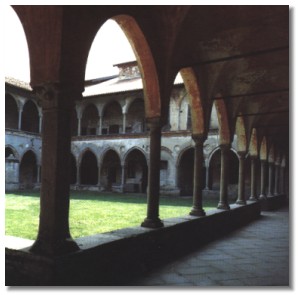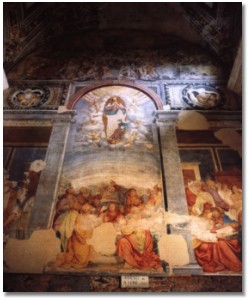
The Benedictine Monastery of Our Lady of the Assumption at Cairate was founded in 737 A.D. by Manigunda, a
Longobard noble woman connected with the Royal Court of Pavia.
 The first reliable document in which the monastery is mentioned, is a bull by Pope John VIII in 877 A.D.In this document the Monasteries of Cairate and Sesto Calende, which were outside the diocese, are confirmed to the Bishop of Pavia. For about a thousand years, the Monastery, which owned the two-third of the territory of Cairate and the four mills, was the economic and social centre of Cairate. The cloister life became a rule only after the Counter-Reformation; no wonder if the xenodochio (hospice), where pilgrims and travellers were offered hospitality, was in the vicinity.
The first reliable document in which the monastery is mentioned, is a bull by Pope John VIII in 877 A.D.In this document the Monasteries of Cairate and Sesto Calende, which were outside the diocese, are confirmed to the Bishop of Pavia. For about a thousand years, the Monastery, which owned the two-third of the territory of Cairate and the four mills, was the economic and social centre of Cairate. The cloister life became a rule only after the Counter-Reformation; no wonder if the xenodochio (hospice), where pilgrims and travellers were offered hospitality, was in the vicinity.
By tradition, it is said that the "Barbarossa", the night before the battle of Legnano, rested with his army in the plain of Cairate; he was given shelter in the guest-quarters. During the works of adaptation of the building to the rules issued after the Council of Trento, the Monastery changed its architectural aspect and was decorated with the frescoes by A. Luini. It was in this period that, according to the historian Tristano Carlo, a sarcophagus was found. You can still see it today: it contains the remains of a lady who is richly dressed and is belived to be Manigunda herself, the founder.
During the works of adaptation of the building to the rules issued after the Council of Trento, the Monastery changed its architectural aspect and was decorated with the frescoes by A. Luini. It was in this period that, according to the historian Tristano Carlo, a sarcophagus was found. You can still see it today: it contains the remains of a lady who is richly dressed and is belived to be Manigunda herself, the founder.
During the Spanish dominations Cairate became a feud, except for the monastery. The end of the monasteries came with the Austrian domination in Italy. Ours survived till 1799 because it showed that it was useful and necessary to the society. But this didn't prevent Napoleon from ordering the suppression with the following sale by auction of the properties.
The building was divided among the four new owners who modified it according to their needs. In 1975 the eastern wing of the cloister was bought by the Town Board, while the western wing became public property only a few years ago, thanks also to the attention and concern of the Provincial Board.
|
|
|
|